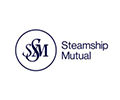Steamship Mutual works with Vale SA on decarbonisation and carbon emission reduction projects

As part of their Ecoshipping Programme Vale SA are committed to supporting the shipping industry in reducing carbon emissions through operational measures and decarbonisation. Vale SA is one of Steamship Mutual’s very longstanding Members and, as part of that programme, they invited the Club to work with them on three projects, including the recently announced plans to install Anemoi Rotor sails on a 400,000DWT Valemax, the world’s largest ore carrier:
Rotor sail installation
The rotor sails are developed by the Norwegian company Norsepower Oy Ltd.
The installations are proven to reduce the power requirements of the main engine by providing a direct thrust to the ship through the ‘magnus effect’ produced by the electrically spun rotors. Vale engaged Norsepower to explore the prospect of installing rotor sails on the 325,000 dwt VLOC Sea Zhoushan. Having analysed the proposed routes for the vessel Norsepower estimated an efficiency gain of up to 8% and a consequential reduction in emissions of up to 3,400 tons of CO2 per year.
To enable cargo operations the rotor sails can be tilted down to the deck.
Air Lubrication System (ALS) installation
The ALS is developed by the UK company Silverstream Technologies.
The ALS produces a carpet of micro-bubbles to reduce friction between the hull and the water. The reduced overall drag on the vessel thereby reduces the fuel consumption on passage. Vale worked with Silverstream to explore the prospect of installing an ALS on the 325,000 dwt VLOC Sea Victoria The expectations were for a fuel reduction of around 5 to 8% which would equate to an annual reduction in emissions for a single vessel of up to 5,600 tons of CO2.
Both vessels are owned by Pan Ocean who partnered Vale in these projects.
The Club was invited to join these projects at the design and risk assessment stage. This involved participation in workshops alongside the ship designers, system manufacturers, ship owners, Vale and Classification Societies.
The risk assessment workshops were undertaken to identify all potential installation and operational hazards (HAZID) associated with these projects.
Where there are no prescriptive requirements and, or where, the shipboard arrangement deviates from any prescriptive arrangement, such as in the case of the Rotor sails and Air Lubrication System, the SOLAS II-1 Regulation 55 makes provision for an alternative design and arrangement as per the guidelines in the MSC.1/Circ. 1455.
For the approval of such innovative designs the guidelines prescribe undertaking a HAZID with the objective of identifying all relevant hazards and their consequences. Where the severity of a hazard is considered to be unacceptable, then the HAZID is intended to identify suitable mitigation measures that are to be implemented.
With the wider implementation and application of new and novel technologies, and the adoption of alternate fuels such as LNG, Methanol and Ammonia, it is anticipated that more vessels will require a HAZID and potentially a Hazard and Operability Study (HAZOP) assessment, to be undertaken.
The Steamship Mutual Loss Prevention Department provided their input and contributed to the discussions during brain-storming sessions in the HAZID workshops, sharing their diverse background, experience, and expertise in engineering and the operation of VLOCs.
Steamship Mutual are proud to support Vale in their journey toward decarbonisation.
Published under the GlobalVoyage2050 Project partnership “A Practical Guide to the Selection of Energy Efficiency Technologies for Ships” provides a useful insight into the various technologies that are available for improving the energy efficiency of ships.
Source: Steamship Mutual
Source link
